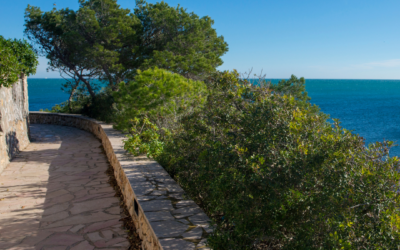One of the best ways to exercise while enjoying the landscape with your family or friends is to ride a bicycle. This means of transport was invented in the 19th century, initially only used by men. Even so, the bicycle became a significant element in the emancipation of women, since, thanks to it, women were able to move around freely.
The bicycle allows us to get anywhere, in a sustainable and ecological way, contributing to the care of the planet and reducing pollution levels. Moreover, in terms of our health, it brings us multiple benefits such as reducing our stress levels and improving our physical condition. Increasingly, municipalities have more and more routes, from easier to more difficult, so that everyone can enjoy them, while discovering all the corners of the environment.
If you are thinking of visiting Costa Dorada you can’t miss any of the cycling routes that we present in this article. Thanks to Shuttle2Sun‘s shared transfer services and private transfer services, low-cost and sustainable, you can move to any location on Costa Dorada, from Barcelona airport, Barcelona port, Reus airport, Girona airport and AVE Camp de Tarragona train station.
Port of Tarragona
One of the many routes that you can do by bicycle, we would like to highlight, first, the Heritage Route of the Port of Tarragona, which consists of following a series of information panels that show you the different elements of the port’s heritage. The route starts at Teatret del Serrallo, where the old Fishermen’s Guild was located, and ends at Banya lighthouse, at the end of Llevant breakwater, which was originally built in the Ebro delta. During the route, you can visit the shelters and sheds of Moll de Costa, the royal staircase, Duaneta, the sundial and the old service building. You can find more information about the Port of Tarragona in our article ‘Discover the Port of Tarragona, on Costa Daurada’.
From Vila-seca to La Pineda
Along the road that links the towns of Vila-seca and La Pineda, Raval de la Mar, there is a perfect route for the whole family. It is a slightly more than 4 kilometres long, not very steep, along which you will come across different places to visit.

First, if you set off from Vila-seca, you’ll come across a large bridge for walking, running or cycling, which crosses over the motorway to connect with Raval de la Mar. Next, you can enter Parc de la Torre d’en Dolça, a 37-hectare green area that includes the tower that bears its name, as well as a Roman villa, old stone quarries and various agricultural constructions. In addition, the park also includes an equestrian circuit, which can be used for horse racing as well as for running.
The construction of Torre d’en Dolça dates back, according to some authors, to the 16th century, although other documents classify it as the old castle of Salou, documented in the 12th century. This tower, with a magnificent strategic location, linked the towers on the coast with those closer to the town.
On leaving the park, a little further on, in the direction of La Pineda, you will come to Santuari de la Mare de Déu de la Pineda, built in the 18th century, which conserves a 13th century defence tower. It was formerly the church and parish church of La Pineda.
Shuttle2Sun offers its shared transfer services and private transfer services, to move to Costa Dorada, from Barcelona airport, Barcelona port, Reus airport, Girona airport and AVE Camp de Tarragona train station.

La Pineda – Salou – Cambrils
Another interesting route to discover the coastline of Costa Dorada is the one that goes from La Pineda to Cambrils, also covering the seafront promenade of Salou. In total, this is a route of up to 11 kilometres.
At the southern end of La Pineda, you can cycle along Pla de Maset cycle lane, which connects with the centre of Salou, crossing the entire Avinguda de Carles Buïgas, recently pedestrianised, until you reach Font Luminosa fountain, which marks the start of Paseo Jaume I in Salou.
Along this great promenade, with an exclusive bicycle lane, you can discover the main beach of Costa Dorada’s tourism capital, Llevant Beach, until you reach the Yacht Club.
Then you’ll link up with Ponent Beach, crossing Vilafortuny along a cycle lane next to the sea, until you finally reach the Cambrils Yacht Club.
Cambrils: From Pinaret to Porta de Ponent
You can follow the previous route to Porta de Ponent. On the way, you can enjoy all the small beaches with crystal clear water that make up Llosa neighbourhood of Cambrils, until you pass the last beach, Ardiaca beach. It is a very peaceful experience that will help you to let your mind go blank, while you enjoy the most beautiful semi-urban landscape.
Other interesting routes
If you are a cycling enthusiast, we suggest you do a couple of routes of more complicated levels, such as the Mare de Déu de la Roca Route, which is about 27 kilometres long and runs around Mont-roig del Camp, leaving from Cambrils, until you reach Mare de Déu de la Roca Chapel, dating from the 13th century and located at an altitude of 294 metres above sea level. It is a small chapel with a single nave, part of which is carved out of the rock. It also has a restaurant specialising in grilled meats, “calçotadas”, pig’s trotters and traditional Catalan salad, made with a sauce similar to “romesco”.
On the other hand, the Cistercian Route, a circular route, with a 2,300-metre climb and a length of up to 108 kilometres. This route takes you to the monasteries of Santes Creus, Poblet and Vallbona de les Monges.
So that you can enjoy these routes to the full, we suggest two accommodation options for your stay: Hotel Augustus, in Vilafortuny (Cambrils), with sea views; and Hotel Palas, in La Pineda, just 80 metres from the beach.
Remember that with Shuttle2Sun‘s shared transfer services and private transfer services, low-cost and sustainable, you can move to any town on Costa Dorada, from Barcelona airport, Barcelona port, Reus airport, Girona airport and AVE Camp de Tarragona train station.



